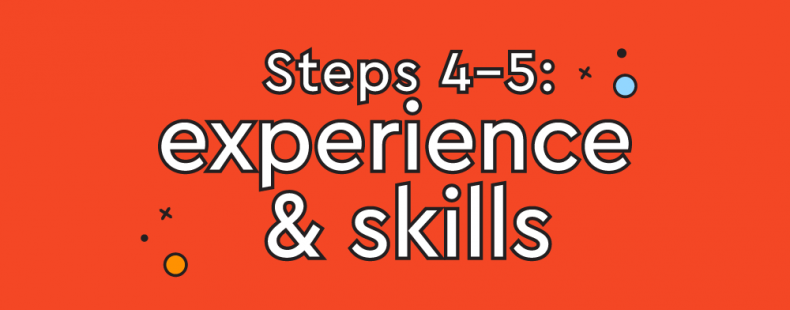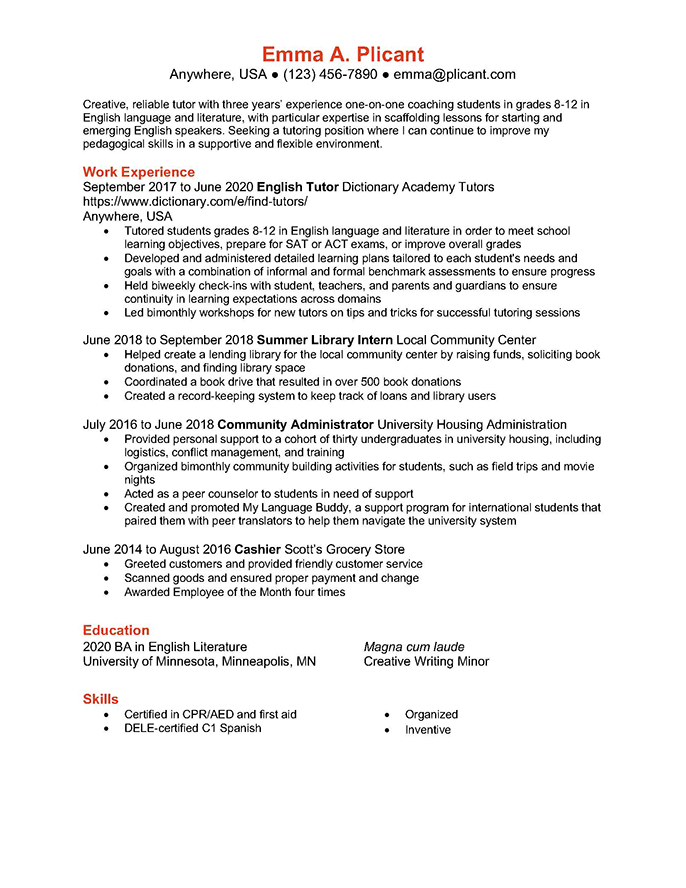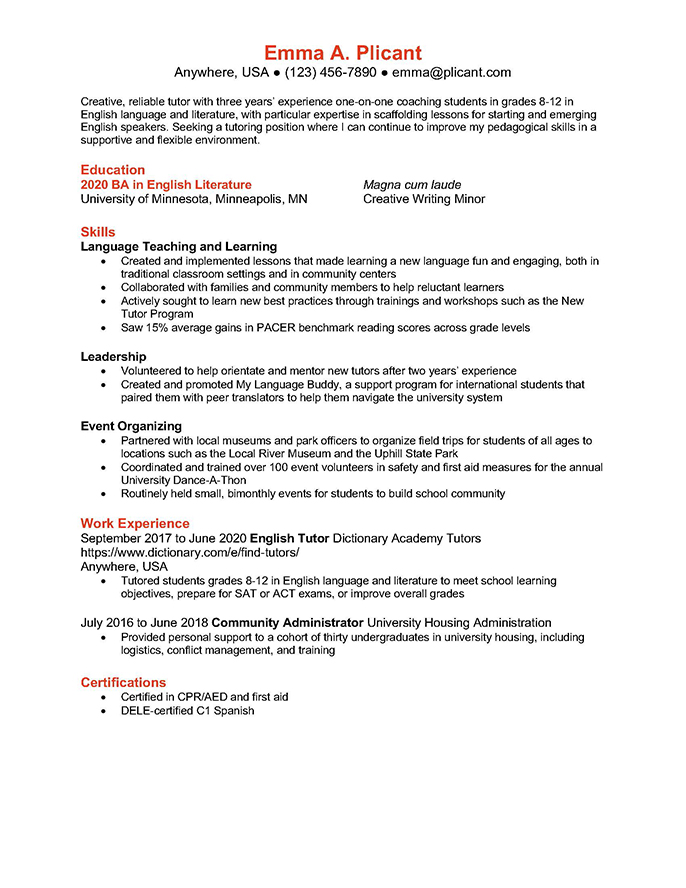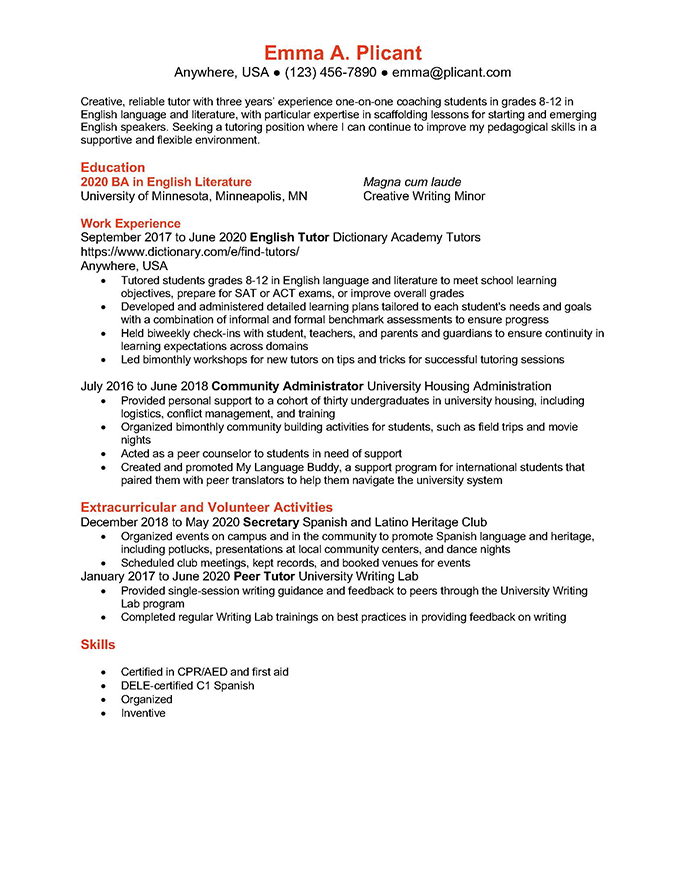After several years working in the industry of your choice, you’re ready to move on to a more challenging position. You have the experience you need—but is your resume ready?
This article covers steps 4 and 5 (out of 10 steps) of how to write a strong resume. Every resume is slightly different depending on the field and personal experience, but there are some general guidelines that everyone should keep in mind when writing a resume. This article provides an overview of how to highlight your work experience and describe specific skills on a resume.
Step 1. Choose a Resume Format
Step 2. Include Appropriate Contact Information
Step 3. Write a Stellar Objective
✅ Step 4. Highlight Relevant Experience
✅ Step 5. Add Relevant Skills to Your Resume
Step 6. Include an Education Section
Step 7. List Certifications and Awards
Step 8. Incorporate Action Verbs, Adjectives, and Other Buzzwords
Step 9. Edit Your Resume
Step 10. Share Your Resume
We’ve provided three sample resumes you can use to follow along in this series and create your own format. There are three templates linked here (click on the images below to expand them), but each format is explained in more detail in step 1 of this series.
- the chronological resume
- the functional resume
- the combination resume
Step 4. Highlight relevant experience
Ideally, a strong resume is tailored to the specific job you are applying for. Read the job posting closely and do some research into the company and position. Mirror the expectations and language of the job posting in your own resume to demonstrate you’re a good fit for the post. Here’s how you can do this.
Education & experience
First, the basics. Most job postings list preferred credentials and number of years of job experience. When writing your resume, you will want to include your credentials in the education section (more on that in second) in a way that makes it clear you match their needs. If the job listing is looking for someone with, say, three years of experience, when describing or accounting your work experience be sure to note the length of time. You might even choose to mention it in the resume summary, as in “Tutor with three years experience.”
Relevant experience is key
Next, the big picture. If you have worked a variety of jobs, or worked multiple jobs at one time, you may not want to list every single experience you’ve ever had on your resume. Instead, you should pick the activities that are the closest match to the job posting. Let’s say, for example, that you are applying for a job in retail. Over the years, you have worked a variety of retail jobs in addition to driving delivery. It would be more important to write in detail about all of your jobs in retail rather than try to squeeze in all your part-time delivery driving. Of course, if you don’t have a lot of work experience or are worried about employment gaps, you can fill out your work experience with less-relevant jobs. However, you should still focus on the work that is most relevant to the position.
Order & structure of experience
Now, let’s look at the structure and language. You will want to list your work experiences in order from most to least recent. For each experience, whether it’s a job, an internship, or even a volunteer activity, you will want to include the following information:
- Approximate dates of employment: month and year, or even just year, is sufficient
- Job title
- Employer
- Location
- Bulleted descriptions of responsibilities
For example:
September 2016–June 2020 English Tutor Dictionary Academy Tutors
Oakland, CA
-
- Tutored students grades 8–12 in English language and literature to meet school learning objectives, prepare for SAT or ACT exams, or improve overall grades
- Developed and administered detailed learning plans tailored to each student’s needs and goals with a combination of informal and formal benchmark assessments to ensure progress
- Held biweekly check-ins with student, teachers, and parents and guardians to ensure continuity in learning expectations across domains
- Led bimonthly workshops for new tutors on tips and tricks for successful tutoring sessions
In step 8 of this series, we’ll discuss how to specifically use action verbs to describe your experience and skills.
Step 5. Add relevant skills to your resume
In addition to work experience, you have skills tailored to your specific job tasks or educational background. Some examples of skills employers may be looking for are knowledge of software programs, languages, or leadership ability. Here are a few examples.
Hard skills
Hard skills are highly specific technical abilities, some of which may require certification or a particular training. Examples of hard skills are knowledge of software languages, translation, or plumbing. If you have hard skills that are relevant to the position, you should include them. Try to avoid skills that it might be assumed that you already have. For instance, if you are applying for a job in information technology (IT), it is probably not necessary to note that you are proficient in Microsoft Office.
Soft skills
The term soft skills can be used to refer to the social skills that help employees succeed and stand out at most workplaces. Hard skills are specific to a job, while soft skills are common across professions. Having a positive attitude or a good management style are examples of soft skills. Generally speaking, your soft skills should be evident from your job descriptions. You may not need to include these in a separate section on your resume. However, if you’re worried about it, or if you feel you have a particular strength in a soft skill, you can note 2–3 of them in a word or two. For example:
If you are still struggling to differentiate between the two, read this article that delves into hard skills and soft skills in more detail.















